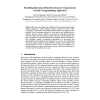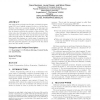62 search results - page 3 / 13 » Homology gives size control in genetic programming |
ICRA
2002
IEEE
13 years 10 months ago
2002
IEEE
— In this paper, we present a method for co-evolving structures and controller of biped walking robots. Currently, biped walking humanoid robots are designed manually on trial-an...
EC
1998
13 years 5 months ago
1998
Parsimony pressure, the explicit penalization of larger programs, has been increasingly used as a means of controlling code growth in genetic programming. However, in many cases p...
CEC
2005
IEEE
13 years 11 months ago
2005
IEEE
The most controversial part of genetic programming is its highly disruptive and potentially innovative subtree crossover operator. The clearest problem with the crossover operator...
IEAAIE
2004
Springer
13 years 10 months ago
2004
Springer
This paper investigates the suitability of linear genetic programming (LGP) technique to model efficient intrusion detection systems, while comparing its performance with artificia...
GECCO
2007
Springer
13 years 11 months ago
2007
Springer
The result of the program encoded into a Genetic Programming (GP) tree is usually returned by the root of that tree. However, this is not a general strategy. In this paper we pres...


